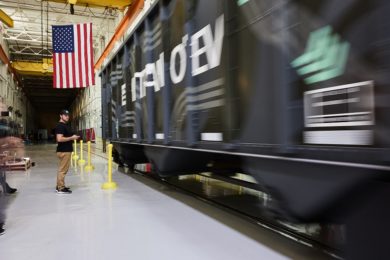 Early in 2012, Schade Lagertechnik, part of the AUMUND group, is to deliver a portal scraper with 48 m of rail track and conveying capacity of 500 t/h for chrome ore to TNK Kazchrome in Kazakhstan. It will be employed in Aktobe near the Russian border, in north-west Kazakhstan. Kazchrome is part of the ENRC Group and is a major ferrochrome producer. The company operates several large ferrochrome plants in Kazakhstan. The new portal scraper spans the stockpiled ore and travels back and forth longitudinally over the stockpile. In this instance and owing to the abrasivity of the material, Schade is employing a scraper chain furnished with a wing roller, the bearing being arranged directly on the shaft. The latter was especially developed for highly abrasive bulk materials.
Early in 2012, Schade Lagertechnik, part of the AUMUND group, is to deliver a portal scraper with 48 m of rail track and conveying capacity of 500 t/h for chrome ore to TNK Kazchrome in Kazakhstan. It will be employed in Aktobe near the Russian border, in north-west Kazakhstan. Kazchrome is part of the ENRC Group and is a major ferrochrome producer. The company operates several large ferrochrome plants in Kazakhstan. The new portal scraper spans the stockpiled ore and travels back and forth longitudinally over the stockpile. In this instance and owing to the abrasivity of the material, Schade is employing a scraper chain furnished with a wing roller, the bearing being arranged directly on the shaft. The latter was especially developed for highly abrasive bulk materials.
The drag link conveyor chain will be used in particular where chain lubrication is not permitted. It is furnished with hardened bolts and bushings which keep the wear factor at a low level. Each link of the bushed chain is additionally equipped with bearings and wing rollers which run in the chain guide. The rollers are furnished with bearings and special seals. An automatic chain tensioning device also ensures a low maintenance requirement. The drive shaft sits in sealed bearings and is fitted with two welded tumblers featuring exchangeable special steel tooth segments. The portal scraper transports the bulk material away in layers from the side slope and guides it over a concrete ramp onto a belt conveyor which is arranged longitudinally adjacent to the stockpile. At the end of the bulk material stockpile the scraper boom lowers by a depth of cut. Then the scraper carries away the next layer in the opposing direction of travel. This process is repeated until the stockpile has been reclaimed in its entirety. Reclamation takes place automatically, while the cutting and grading of the stockpile is usually performed manually by the operators in Aktobe. During reclamation chains and drives run continuously whilst the angle of slope of the stockpile and the front ends of the stockyard are monitored automatically. This monitoring enables the scraper to travel up to the headwall, save for a minimal safety distance. Simultaneous monitoring of the angle of slope prevents the collapse of the side of the stockpile.









